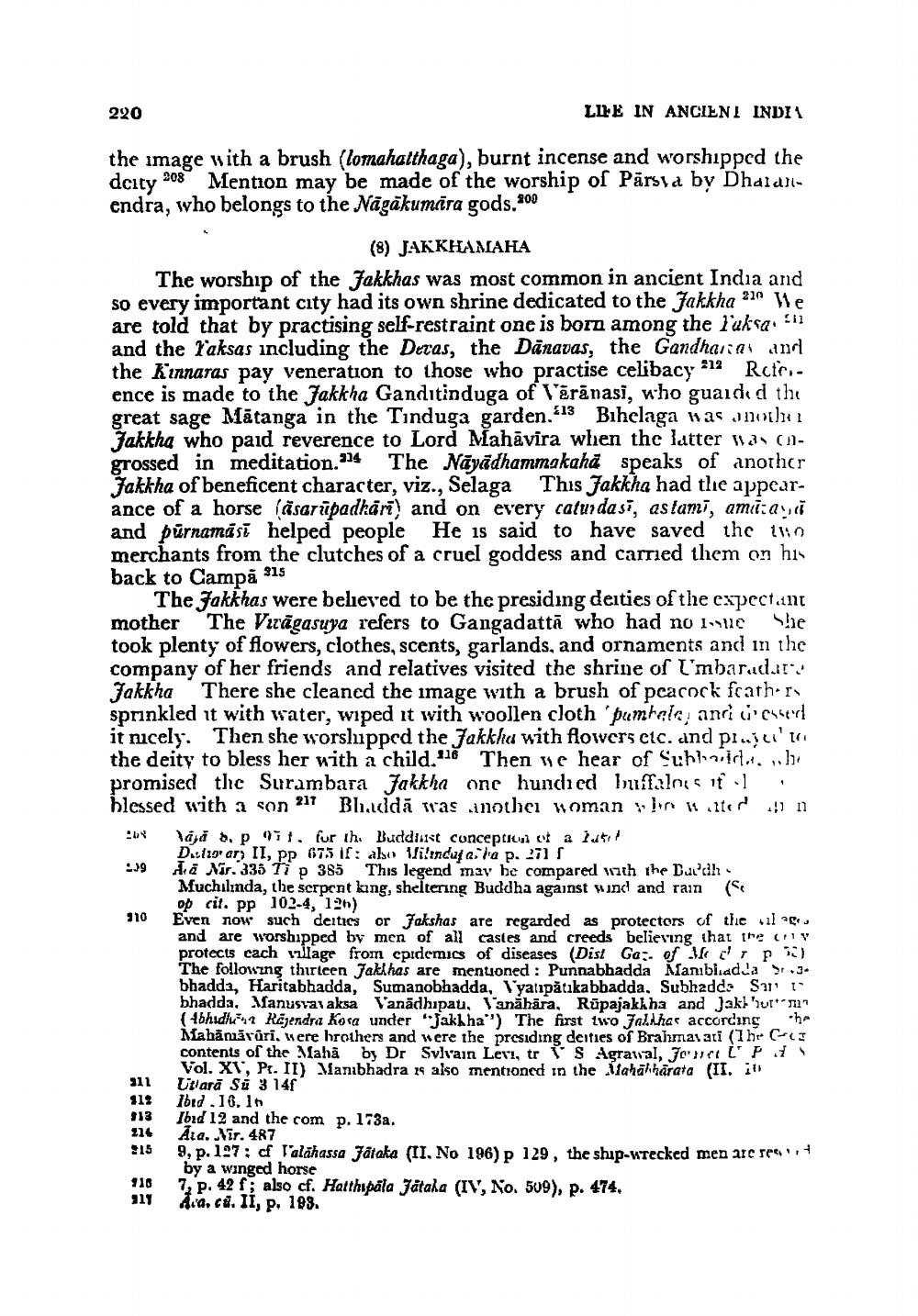________________
220
LL-E IN ANCIENT INDI
the image with a brush (lomahatthaga), burnt incense and worshipped the dcity 208 Mention may be made of the worship of Pārsia by Dhaidla endra, who belongs to the Nāgākumira gods.200
(8) JAKKHAMAHA The worship of the Fakkhas was most common in ancient India and so every important city had its own shrine dedicated to the Fakkha 20 le are told that by practising self-restraint one is born among the luksa 1 and the raksas including the Deras, the Dänavas, the Gandhanas anal the Kinnaras pay veneration to those who practise celibacy 212 Retri. ence is made to the Jakkha Ganditinduga of Vārānasi, who guarded the great sage Mātanga in the Tinduga garden (13 Bihelaga was J100H Jakkha who paid reverence to Lord Mahāvīra when the latter was (1) - grossed in meditation.934 The Nāyādhammakahā speaks of another Jakkha of beneficent character, viz., Selaga This Jakkha had the appearance of a horse (äsarūpadkārī) and on every catur dasī, astami, amiauci and purnamas helped people He is said to have saved the 110 merchants from the clutches of a cruel goddess and carried them on his back to Campå 315
The Jakkhas were believed to be the presiding deities of the expectint mother The Vizāgasuya refers to Gangadattā who had no 1-10 She took plenty of flowers, clothes, scents, garlands, and ornaments and in the company of her friends and relatives visited the shrine of l'mbarudar Jakkha There she cleaned the image with a brush of peacock feathers sprinkled it with water, wiped it with woollen cloth 'pumhals, anri ülessed it nicely. Then she worshipped the Jakkha with flowers ctc. and pijlt the deity to bless her with a child. '16 Then we hear of Schlaista...) promised the Surambara Jakkha one hundied buifalositi blessed with a son 217 Biddā tras unothei woman in late 11 6 aya di p971. for the Buddhist concept of a lui
D..119'ar) II, pp 67,5 1f: ako Hilinductap. 2i1f :59 de Mar. 335 Tip 385 This legend may be compared with the Dudh -
Muchılında, the serpent kang, sheltering Buddha against wind and rain ( op cit. pp 102-4, 12) Even now such derties or Jakshas are regarded as protectors of the il and are worshipped by men of all castes and creeds believing that the IV protects cach vallage from cpidemics of diseases (Dis! Ga.. of U T P ) The following thirteen Jaklhas are mentioned: Punnabhadda Manıblıada $1.3. bhadda, Haritabhadda, Sumanobhadda, V'yalipatikabbadda, Subhadda Suri bhadda, Manusvavaksa Vanādhipau, Vanahāra, Rūpajakkha and Jakt hurt ( bhidha Rajendra Kora under Jakha') The first two fallhas according that Mahämäräri, were brothers and were the presiding deities of Bralumai ari (1 hr Ce contents of the Maha by Dr Sylvain Levi, tr VS Agrawal, Jori LP
Vol. XV, Pr. II) Manıbhadra xs also mentioned in the Vlahābhārata (II. i! 311 Uitlară Su 3 148 114 Ibid. 16. in 913 Ibid 12 and the com p. 173a. 214 Aia. Mir. 487 215 9, p. 197: of Talāhassa Jätaka (II. No 196) p 129, the ship-wrecked men are rest
by a winged horse 7, p. 42 f; also cf. Hatthipala Jataka (IV, No. 509), p. 474. Ara.ca. II, p. 199.
910
116




